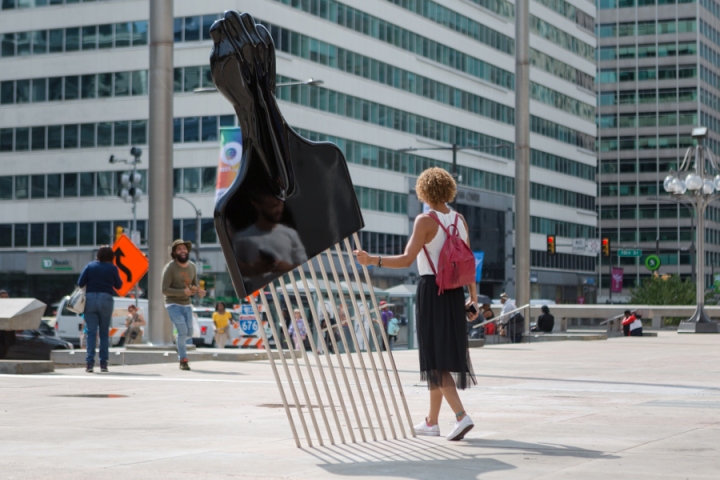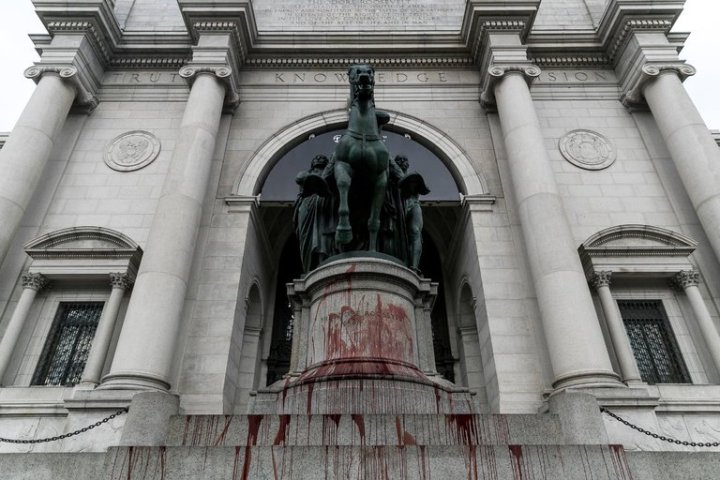Presenting a paper recently on the monumental sculptural projects of Alexander Calder, David Smith, and Robert Smithson in Italy, as a part of the Smithsonian American Art Museum’s wonderful symposium The Course of Empires: American-Italian Cultural Relations, 1770-1980, (my presentation and the entire proceedings are viewable here, if you are so inclined), I drew upon two quotes from the mid-twentieth century on the topic of monumentality:
“Every period has the impulse to create symbols in the form of monuments, which, according to the Latin meaning are ‘things that remind,’ things to be transmitted to later generations. This demand for monumentality cannot, in the long run, be suppressed. It tries to find an outlet at all costs.”
-Sigfried Giedion, “The Need for a New Monumentality,” 1944
“The very notion of a modern monument is a contradiction in terms: if it is a monument, it cannot be modern, and if it is modern, it cannot be a monument.”
-Lewis Mumford, “The Death of the Monument,” 1937
These quotations were deployed in service of a paper examining three geographically-specific modern sculpture projects, created during the postwar period, and shaped by the idea of monumentality, i.e. the condition of being monumental, rather than as a means to discuss them as monuments, as sculpture meant to commemorate or memorialize. While I always hope my scholarship has some relevance to the present beyond just historic significance, these quotations were selected for their connection to cultural debates occurring at midcentury. Giedion’s call for permanence, for “things that remind” and Mumford’s declaration of the impermanence of the modern, for the new, now, and next, however, continue to reverberate and I would argue encapsulate the dichotomy at the heart of current discussions around monuments and monumentality. Perhaps unsurprisingly, one of the questions I received during the Q&A at Course of Empires was about how those “historical” works relate to contemporary debates, with a specific reference to the remarkable Monument Lab project currently taking place in Philadelphia. My own inadequate answer to this question has been churning and asserting itself every day since, and what I am wrestling with is the question of permanence.

Just a few days after Course of Empires, I attended a two day “Public Art Symposium,” organized by the Chicago Department of Cultural Affairs and Special Events as a part of the city’s Year of Public Art programming. I was again confronted with the issue of permanence, loss, and monuments. There was (often contradictory) discussion of “fleeting monuments,” preservation, conservation, gentrification, inclusivity, “spatial justice,” the role of artists and art within civic infrastructure, and the public unveiling of the City’s (rather shockingly) first Public Art Plan (which you can read in full here). Michelle Bogart, who has been a steadfast and significant voice in the recent debate around the removal of public statuary, and who has discussed elsewhere the profound “historical loss” that comes with a blind, iconoclastic removal of such works, posed the question: are monuments disposable? In her talk, she reminded the audience that monuments do not have to necessarily celebrate their subjects, but can provide palpable, historically contextualized teaching opportunities–which should go without saying, is very different than the sentiment expressed in the wake of Charlottesville that simply decried the removal of “those beautiful statues.”
Over two days of sessions, activists, administrators, artists, conservators, curators, patrons, and scholars discussed a diversity of strategies and viewpoints related to the role of public art in the twenty-first century, and shared some of the exciting ways they were helping invigorate civic spaces with public art projects (Theaster Gates putting in a DJ booth in the 95th Street CTA station in Chicago, was but one example). What struck me, however, was the dissonant if co-existent temporal dimension inherent to public art in the present sphere. On the one hand there was an expectation and need for tangible, permanent interventions, whether murals, sculptures, or architectural structures–and an expression of sadness when the preservation of such objects failed, whether the landmark Wall of Respect in Chicago or the destruction of the Buddhas of Bamiyan in Afghanistan and historical sites across of Syria. There was also an emphasis on what one speaker continually referred to as the “contemporary/ temporary,” which privileges ephemeral artistic interventions in public spaces.Such modes of installation or activation are often deeply informed by and responsive to the socio-historical contexts of their creation. The allure and benefit of such approaches is clear, and is definitely the way of the future–one need only read this “report” on the Museum of Ice Cream or follow the saga of the recently announced Newfields, née Indianapolis Museum of Art to see how the tide is changing.

I am not unsympathetic to the motivations behind recent calls to remove, for example, statues representing Confederate figures, nor am I decrying the contemporary turn writ-large occurring across culture. As a historian, however, I do worry about the ramifications of privileging a culture of the present. Listening to the speakers at the Public Art Symposium, I could not help but think of the culture of destruction and vandalism growing around the moribund statues of problematic pasts (and presents), as seen only this past week with the statue of Theodore Roosevelt in front of the American Museum of Natural History, and the flashy, shiny, ahistorical public art projects of the fleeting now as two sides of the same coin. So many manifestations of what might broadly be called the contemporary/ temporary purport to the democratic and the inclusive, but still remain tinged with an air of the exclusive, and in their embrace of the fleeting, contribute to a pervasive (and depending on your viewpoint, insidious) untethering that can be seen across contemporary culture. There are of course a diversity of examples, from the rapid turnover of the 24 hr. news cycle to freelance/gig employment down to the spectacularized contemporary arts exhibition, which is to say that across the cultural landscape of the twenty-first century in the United States, there has been a move to the contemporary/ temporary. Food trucks and pop-ups are upending the traditional restaurant model. A large majority of consumer goods are designed and manufactured within the framework of planned obsolescence—you buy the iPhone 7 knowing that the 8, 9, and X are just around the corner. Fast fashion is bought, worn, and discarded with each new season. There is also the manic consumerism of the limited edition/ timed release of all-star sneakers, fashion collaborations, and exclusive capsule collections. The common thread is brevity, and, of course, their valuation via social media. Each of these examples become instant fodder for Instagram, Snapchat (itself a platform built on transience), Twitter, and Facebook, and then seemingly lost into the ethers as the newest, hottest, next thing comes along.
There is of course a reverse reaction, seen in everything from the fetishization of vinyl, the quality of the handcrafted, or even the art historian (perhaps nostalgically) yearning for the tangible, permanent object. The debates around historical statues, contemporary art, and culture in 2017 feel like tremendously fraught, complex (public) topics for discussion and even as I conclude this post, I feel some trepidation in expressing any opinions–even if they are meant to engender conversation not declare the rightness of my personal viewpoint. What is the role of the “permanent” and what might “monument” mean in the twenty-first century? Is there a still, as Giedion asked of the twentieth-century, still a need for monumentality, and if so, what might that look like? I do not know that I have an adequate answer–though I am certain that there is not just one–but I am concerned that in this newfound age of iconoclasm, Snapchat, and the contemporary/ temporary, something is being lost. I remain an optimistic historian and celebrate the possibilities of a future that advances whether I like it or not, but if the title of this post seems tinged with a nostalgic remorse, it is because I also worry about what might be lost in such a transition. At a moment when history itself feels questioned, devalued, and under threat, I guess I am longing for a little more permanence.

